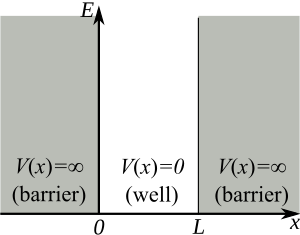Quantum Chemistry/Example 25: Difference between revisions
imported>MathXplore |
(No difference)
|
Latest revision as of 06:43, 18 November 2023
Introduction

The particle in a one-dimensional box model describes the movement of a particle in one dimension. It is confined to a "box" where it can only move horizontally along the x-axis within the confines of the box. The particle cannot escape the box due to the areas outside of the box having an infinite potential energy, thus trapping the particle inside an infinitely deep well. If the leftmost boundary of the box is position 0 and the rightmost position is position L, the potential energy of the particle inside the box is zero between position 0 and L. This is denoted mathematically as where is potential energy as a function of position. Outside the box, the potential energy is for and . The problem below proposes a situation where the potential energy is zero everywhere along the x-axis, meaning the particle is no longer bound by areas of infinite potential energy like in the 1D box model. Rather, across the interval .
Example Problem and Solution
Problem
Suppose an electron is free to move along the x-axis and its potential energy everywhere is zero. Derive a wavefunction for this system.
Solution
Schrödinger Equation and Definition of the Hamiltonian
First the Hamiltonian operator must be defined in order to solve the Schrödinger equation for this system.
Time-independent Schrödinger equation
The Hamiltonian is simply the total energy of the system. It is expressed as the sum of the total kinetic energy () and total potential energy () of the system. Therefore the Hamiltonian is defined as,
However, the problem states that the potential energy everywhere is zero, so the Hamiltonian is simply equal to the total kinetic energy of the system.
Definition of the Kinetic Energy Operator and Substitution into the Schrödinger Equation
In one dimension, the kinetic energy operator is defined as,
So the Hamiltonian becomes,
Where is the mass of an electron and is the reduced Planck's constant. This can then be substituted into the Schrödinger equation to give,
The above is simplified by multiplying both sides of the equation by and then dividing both sides by .
Finding a General Solution and Solving the Differential Equation
is a linear homogenous second order differential equation where , so,
Since the potential energy everywhere is zero, the electron can exist anywhere on the x-axis. The position of the particle exists across the interval , therefore the probability of finding the electron at any position is infinitely small and approaches zero.
Thus it can be assumed that for both terms of the general solution due to the absence of any boundary conditions. Putting into the general solution yields,
Therefore, the wavefunction collapses and is zero if the potential energy is zero everywhere along the x-axis, due to the probability of finding the electron at any position being infinitely small.